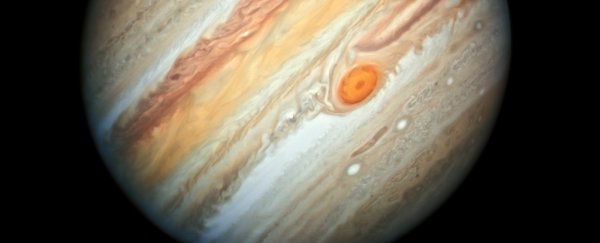Recently, Jupiter entered a position in the sky known as opposition: almost directly opposite the Sun from Earth. It's the perfect time for eyeballing our Solar System's biggest planet - and the Hubble Space Telescope got in on the action.
On 27 June, as opposition was waning, Hubble snapped a stunning new photo, revealing Jupiter in all its turbulent, varicoloured splendour.
Prominently displayed almost dead in the middle is the Great Red Spot, the colossal anticyclonic storm larger than the entire diameter of Earth, its winds blowing widdershins at speeds up to 680 kilometres per hour (425 miles per hour) between two bands of clouds.
The storm, raging in the planet's atmosphere, towers 5 kilometres (3 miles) above the clouds around it, drawing filaments from the surrounding cloud into its vortex. Interestingly, the centre is relatively calm - just like a hurricane on Earth.
Although we think the Great Red Spot has been around for around 350 years, in recent years, images show that the storm is shrinking. This latest photo is no exception. Planetary scientists are itching to get to the bottom of this peculiar shrinkage, but so far it's still a mystery.
 (NASA, ESA, A. Simon/GSFC, and M.H. Wong/UC Berkeley)
(NASA, ESA, A. Simon/GSFC, and M.H. Wong/UC Berkeley)
Those bands of colour are no slouches, either, in either turbulence or mystery. They're powered by winds that zoom around the planet in alternating directions at speeds up to 540 kilometres per hour (335 miles per hour).
The light bands are called zones, and the dark bands are called belts, and what creates them is still poorly understood - the zones are believed to be given their colour by ammonia ice, but the reason behind the belts' hue is less clear.
According to NASA, gases from Jupiter's interior could be rising to colour the cloud tops. But the zones have thicker clouds and rise higher than the belts.
The Great Red Spot isn't the only storm on Jupiter. Just below it in the image, you can see two white spots - those are also anticyclonic storms, while the long wiggly worm-shape above them is a clockwise-rotating cyclonic storm.
 (NASA, ESA, A. Simon/GSFC, and M.H. Wong/UC Berkeley)
(NASA, ESA, A. Simon/GSFC, and M.H. Wong/UC Berkeley)
These storms can hang around for years, sometimes merging into each other to form a Frankenstorm (not really the official name; it's just a bigger storm).
Jupiter's atmosphere is around 86 percent hydrogen. Helium makes up 13.6 percent. That remaining 0.4 percent is where all the ammonia, methane and water is accounted. Hydrogen is, of course, highly flammable, but in the absence of oxygen, the gas can't combust - which is why the planet's entire atmosphere doesn't simply catch fire when a meteor hits.
A number of instruments are continuing to monitor Jupiter in the hopes of revealing what its tremendous clouds are hiding, including the incredible amount of data being sent home by the Juno probe.
